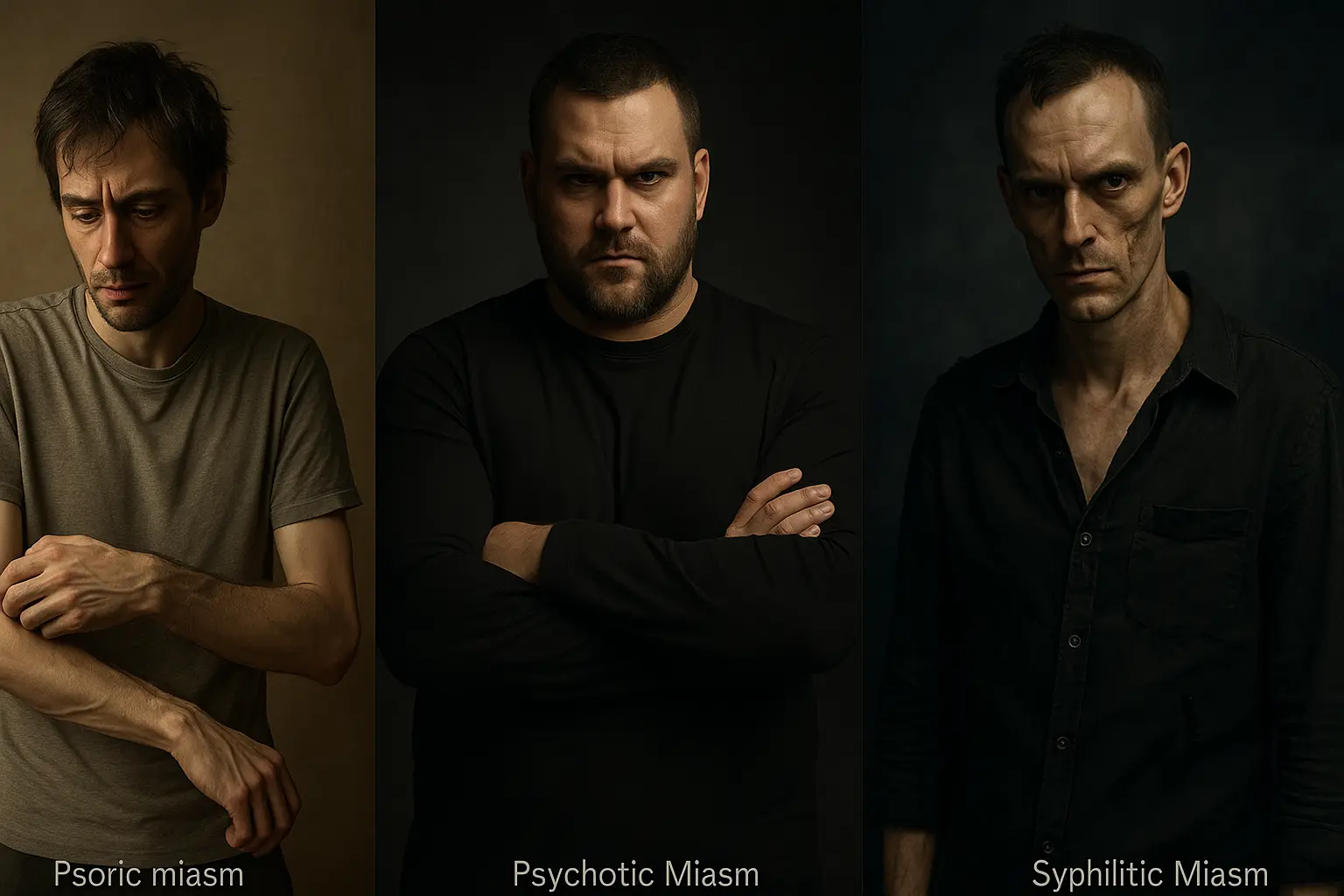What is Miasm– An Easy Explanation

Hahnemann’s Discoveries and Philosophy
When Dr. Samuel Hahnemann observed that many illnesses kept recurring and could not be permanently cured through conventional treatments, he began investigating the deeper causes behind such chronic conditions. His research led him to a concept which he named miasm. Hahnemann stated that unless the root, hidden cause of a disease is addressed, true and lasting recovery is not possible. Merely treating the symptoms will only lead to the illness returning again and again.
Definition and Core Concept of Miasm
To explain miasm in simple terms, Hahnemann described it as an invisible yet deeply active toxic influence that makes the body susceptible to disease and also affects the mind and emotions. It is not an external germ, but rather an internal “disease tendency” that lies dormant within us and can become active due to environmental factors, hereditary traits, and life experiences.
The Three Primary Miasms:
Psoric – Mentally, it is associated with fear, anxiety, depression, and restlessness. Physically, it manifests as allergies, itching, and general weakness.
Sycotic – Characterized by excessive physical growth, a secretive nature, and introversion.
Syphilitic – Marked by destructive thoughts, suicidal tendencies, and degenerative conditions such as cancer or ulcerative diseases.
All three miasms affect both the body and mind in various forms.
Why Understanding Miasms is Important – From a Doctor’s and a Patient’s Perspective
From a Homeopathic Doctor’s Perspective:
A physician’s primary goal is to ensure the patient’s complete recovery—but this can never be achieved by treating only the symptoms. Miasm is the deep-rooted obstacle that prevents true healing. Therefore, the doctor must first identify which miasm is active in the patient, how deep it has penetrated, and how to eliminate it effectively.
👉 Because unless the miasm is removed, no treatment can bring about a permanent cure.
As Hahnemann himself stated, “to remove the total disease, the miasm must be annihilated from its root.”
Here, it is not the Totality of Symptoms, but the Totality of the Disease that must be understood—and miasm is the key to that understanding.
From a Patient’s Perspective:
Patients usually only experience the symptoms—fever, joint pain, low mood, etc.—without realizing that these may be manifestations of an underlying miasmatic cause. Therefore, it is important to help the patient understand, through analysis of their mental state, past medical history, and family disease tendencies, that they are affected by a deeper imbalance.
When a patient understands that their illness may stem from deep mental or genetic causes, they become more aware and cooperative in the treatment process.
Miasm is not just a medical theory—it is a form of philosophical understanding that provides deep guidance on the path to complete healing. A skilled homeopath’s responsibility is not only to diagnose the disease, but also to identify the miasmatic block and gradually eliminate it.
Because treating only the symptoms is like removing the smoke while the fire still burns inside. Eliminating the miasm means extinguishing the fire at its source.
The History of Miasm and Hahnemann’s Explanation

The Role of Miasm in the Organon of Medicine
Dr. Samuel Hahnemann presented the fundamental principles of homeopathy in his timeless work Organon of Medicine. However, the concept of miasm was first discussed in detail in his other significant book, The Chronic Diseases: Their Peculiar Nature and Their Homoeopathic Cure, published in 1828. While the Organon introduces the preliminary idea and perspective of miasm, the comprehensive discussion primarily takes place in The Chronic Diseases.
In aphorisms §78 to §81 of the 5th edition (1833) and 6th edition (1842) of Organon of Medicine, chronic diseases and their deep-rooted causes—miasms—are highlighted. Here, Hahnemann explains that if a disease recurs frequently and becomes long-lasting, there must be a deep, invisible, and active cause behind it, which he refers to as a miasm.
The Three Fundamental Miasms:
Psora – The root cause of both physical and mental weakness, itching, and various chronic symptoms.
Sycosis – Originating from sexually transmitted diseases like gonorrhea, it leads to abnormal growths and wart-like symptoms.
Syphilitic – Derived from the disease syphilis, it is characterized by destructive tendencies, ulcers, and bone degeneration.
Hahnemann believed that these three miasms are at the root of most chronic diseases. To diagnose and treat effectively, one must first identify the underlying miasm.
How Hahnemann Arrived at the Theory of Miasm
By observing the recurrence of diseases, Hahnemann realized that permanent cure is not possible by treating only the external symptoms. His experience showed that while treatment might temporarily remove the symptoms, they would often return after some time. This observation led him to understand that there exists a persistent, hidden cause at the root of the disease.
In his search for this hidden cause, Hahnemann discovered the existence of Psoric, Sycotic, and Syphilitic miasms. He built the foundation of his diagnosis and treatment on this deeper understanding. According to him, if a patient’s miasm can be accurately identified and addressed, the disease can be eliminated from its root.
And it is here that he connected the theory of miasm with the core principle of homeopathy—“Similia Similibus Curentur” or “Like cures like.”
The Evolution of the Miasm Theory Over 200 Years
The miasm theory, which brought a new perspective to medical science during Hahnemann’s time, has evolved significantly over the past 200 years. In modern homeopathy, the concept of miasm has been expanded to include aspects such as mental health, heredity, immune disorders, and genetic predispositions.
Although many critics label the miasm theory as outdated or unscientific, numerous experienced homeopathic practitioners consider it effective in identifying the underlying causes of disease. Efforts are being made to integrate miasm-based treatment with modern medical approaches to ensure the holistic well-being of patients.
As a result of this evolution, the miasm theory is no longer just a historical concept—it has become a vital pillar of modern homeopathy.
Psoric Miasm: Symptoms, Nature, and Treatment

Physical Symptoms and Nature of Diseases
According to homeopathic theory, the Psoric miasm is a latent disease tendency that predisposes individuals to conditions like laziness, weakness, and allergies. Common physical symptoms associated with this miasm include:
Allergies and Itching: Individuals affected by the Psoric miasm often suffer from itching, skin rashes, and allergic reactions.
Weakness and Fatigue: One of the primary symptoms of this miasm is a persistent feeling of physical weakness and exhaustion in the patient.
Skin Disorders: Various skin-related issues may arise, such as dryness, psoriasis, eczema, and other forms of skin discomfort.
Respiratory Issues and Flu-like Symptoms: Individuals affected by the Psoric miasm may experience respiratory problems such as asthma or shortness of breath.
Digestive Issues: Problems with digestion—such as gas, constipation, and bloating—are common among individuals with Psoric miasm.
All these symptoms are generally considered indicators of the Psoric miasm in homeopathic treatment. If they are chronic or recurring, they may be the result of the influence of an underlying miasm.
Mental and Emotional Characteristics
The Psoric miasm affects not only the physical body but also has significant impacts on mental and emotional well-being. Key mental and emotional characteristics commonly seen in individuals influenced by this miasm include:
Fear and Anxiety: Individuals affected by the Psoric miasm often experience irrational fears and anxiety. They commonly feel insecure and become overwhelmed with worry about the future.
Low Self-Esteem: Individuals influenced by this miasm often doubt their self-worth and repeatedly perceive themselves as incapable or inadequate.
Loneliness and Isolation: Individuals affected by the Psoric miasm often feel lonely. They may show little interest in forming social connections and prefer to remain distant from others.
Emotional Restlessness: A person influenced by the Psoric miasm tends to be emotionally unstable, with frequent mood swings and difficulty in controlling their emotions.
Additionally, individuals affected by the Psoric miasm often struggle with feelings of hopelessness and lack of motivation. They may perceive every aspect of life as uncertain or overwhelming, which leads to increased mental stress.
Suitable Homeopathic Remedies for Treating Psoric Miasm
In homeopathic treatment, several specific remedies are used to address the Psoric miasm, depending on the individual’s symptoms. Some of the most commonly prescribed homeopathic remedies include:
Sulphur: One of the most commonly used remedies for individuals affected by the Psoric miasm. It is primarily prescribed for skin issues, psoriasis, itching, and allergic conditions. This remedy helps restore both physical and mental balance in the body.
Calcarea Carbonica: This remedy is used for treating physical weakness, fatigue, allergies, and calcium deficiency-related problems such as bone disorders and difficulty in walking.
Natrum Muriaticum: This remedy is effective for individuals affected by the Psoric miasm who experience emotional depression and a sense of loneliness. It helps address emotional instability and supports the patient in returning to a balanced and normal lifestyle.
Silicea: Beneficial for skin and digestive problems caused by the Psoric miasm. It helps reduce dryness in the body and supports the enhancement of both physical and mental strength.
Arsenicum album: This remedy is suitable for individuals who are physically weak and mentally anxious, often preoccupied with cleanliness and order.
When used appropriately according to the symptoms of Psoric miasm, these homeopathic remedies can significantly improve both the physical and mental health of the patient. However, it is essential to consult an experienced homeopathic practitioner, as selecting the correct remedy plays a crucial role in restoring the patient’s overall well-being.
Sycotic Miasm: Suppressed Tendencies and Overgrowth

Physical Symptoms and Nature of Diseases
The Sycotic miasm is a type of disease tendency that affects individuals both physically and mentally in distinct ways. The physical symptoms associated with this miasm typically point toward certain types of growths and excesses. Some of the key symptoms include:
Overgrowth or Excessive Development: Individuals affected by the Sycotic miasm often experience abnormal physical growth, such as hypertrophy in muscles or excessive development in certain parts of the body.
Fibroids and Nodular Growths: Patients with the Sycotic miasm often develop fibroids, cysts, or other abnormal nodular growths, particularly around joints. These types of overgrowths tend to recur even after treatment.
Blood and Hormonal Imbalances: Individuals affected by the Sycotic miasm may show abnormalities in overall blood profiles, such as hormonal imbalances, high cholesterol levels, or issues like hypertension.
Digestive Issues: The effects of the Sycotic miasm can also extend to the digestive system, leading to problems such as overeating or difficulty in digestion.
The physical symptoms of the Sycotic miasm are generally characterized by overgrowth, excess, and the development of abnormal physical conditions.
Mental Symptoms and Behavior
The mental symptoms of the Sycotic miasm primarily lead to unusual tendencies and behavioral changes in an individual. It often creates a sense of excessiveness, secrecy, and an inner feeling of being trapped. Some of the key characteristics include:
Secrecy and Concealment: Individuals affected by the Sycotic miasm often show a tendency to hide their thoughts or behaviors. They prefer to keep their personal life and inner feelings highly private and frequently conceal them from others.
Excessive Need for Control: Individuals influenced by the Sycotic miasm often display a strong desire to control everything around them. When things do not go according to their expectations, they may experience mental restlessness and frustration.
Sense of Isolation: Patients affected by the Sycotic miasm often feel mentally disconnected from society and prefer solitude. They tend to experience a sense of distrust and a tendency to withdraw from the outside world.
Mental Conflict or Overthinking: Individuals with the Sycotic miasm often experience internal mental conflict—either by overthinking a single issue for a long time or by facing a constant stream of conflicting thoughts within the mind.
Additionally, these individuals often become highly emotional about their thoughts or feelings and may get easily agitated.
Therapeutic Approach and Commonly Used Remedies
The treatment of the Sycotic miasm largely depends on the individual’s physical and mental symptoms. In homeopathy, there are specific remedies used to address the Sycotic miasm, selected according to the patient’s unique symptom profile. Some of the key remedies include:
Thuja: এই রেমেডি সাইকোটিক মায়াজমের জন্য খুবই কার্যকর, বিশেষত যারা নিজেকে গোপন রাখেন এবং বাইরের পৃথিবী থেকে আলাদা অনুভব করেন। এটি তাদের জন্য যারা অতিরিক্ত চাপ বা উদ্বেগ অনুভব করেন।
Medorrhinum: This remedy is used in cases where the Sycotic miasm manifests through secrecy and an exaggerated sexual drive. It helps to alleviate the patient’s inner restlessness and feelings of fear.
Nux Vomica: This remedy is beneficial for individuals affected by the Sycotic miasm who suffer from excessive stress and physical discomfort. It helps relieve bodily tension and mental restlessness.
Arsenicum Album: This is an excellent homeopathic remedy for individuals who suffer from intense anxiety and live with an overwhelming sense of insecurity. It provides mental relaxation and helps reduce the persistence of emotional unrest.
Causticum: This remedy is highly effective for individuals who experience physical discomfort along with mental stress due to the Sycotic miasm. It strengthens the patient mentally and helps eliminate abnormal physical tendencies.
The treatment of the Sycotic miasm requires a highly individualized and patient-centered approach, where both the physical and mental aspects of the patient are thoroughly analyzed to determine the most appropriate homeopathic remedy.
Syphilitic Miasm: The Power of Destruction and the Shadow of Despair

Physical Degeneration and Chronic Diseases
The Syphilitic miasm is considered one of the most dangerous miasms in homeopathy, exerting a profoundly destructive influence on the body. Under its impact, individuals often progress toward severe physical degeneration, frequently resulting in chronic and long-lasting diseases. The symptoms of the Syphilitic miasm typically involve tissue breakdown and the destruction of specific organs. Some of the major symptoms include:
Bone Degeneration and Swelling: Individuals affected by the Syphilitic miasm may experience deterioration in bones, particularly in joints such as the knees, hips, and shoulders. This can lead to chronic pain, swelling, and stiffness.
Damage to Skin and Tissues: The Syphilitic miasm often leads to abnormal conditions of the skin, tissues, and other organs. Conditions such as psoriasis, ulcers, open wounds, or even gangrene may develop as a result.
Weakened Immunity: This miasm weakens the body’s immune system, making it more vulnerable to infections and illnesses, which tend to spread rapidly. Wounds take a long time to heal and often reappear.
দীর্ঘস্থায়ী ব্যাধি: সিফিলিটিক মায়াজমে আক্রান্ত রোগীরা একাধিক দীর্ঘস্থায়ী রোগে ভোগেন, যেমন হৃদরোগ, কিডনির সমস্যাসমূহ এবং মস্তিষ্কের ক্ষতি।
Although these destructive effects on the body can often be managed to some extent with medication, the disease may continue to recur if the root cause—the miasm—is not addressed. Therefore, treating the Syphilitic miasm is highly complex and time-consuming.
Mental Characteristics: The Pull Toward Self-Destruction
The Syphilitic miasm is not limited to physical deterioration—it also deeply affects an individual’s mental and emotional state. Its mental characteristics often include a pull toward self-destruction and overwhelming despair. Some of the key traits include:
Suicidal Tendencies: Individuals affected by the Syphilitic miasm may become so mentally devastated that they begin to have suicidal thoughts. They often feel indifferent toward life and look for a way to escape due to overwhelming sorrow.
Destructive Thoughts and Emotions: Individuals influenced by this miasm often suffer from a lack of self-confidence, depression, and a persistent sense of guilt. They are frequently overwhelmed by destructive thoughts and feelings of hopelessness.
Deep Guilt: Individuals affected by the Syphilitic miasm often feel a profound sense of guilt for perceived wrongdoings and believe that their lives are headed toward inevitable destruction.
Distrust and Isolation: They often believe that they have no meaningful role in society and feel completely isolated. This deep sense of disconnection severely affects their mental well-being.
Additionally, individuals affected by the Syphilitic miasm may at times become extremely restless and uncontrollable. They may experience constant agitation and anger, which further deteriorates their mental condition.
Treatment Approach and Commonly Used Remedies
The treatment of the Syphilitic miasm can often be complex and long-term. However, with the correct homeopathic remedies, it is possible to manage and control its effects. Some commonly used homeopathic remedies for addressing the Syphilitic miasm include:
Mercurius Solubilis: One of the primary remedies for the Syphilitic miasm. It helps heal cellular and skin damage rapidly and acts effectively on ulcerated areas. It also alleviates symptoms like excessive body heat and inflammation.
Syphilinum: This is a highly beneficial remedy for treating the Syphilitic miasm. It is commonly used for patients with chronic degenerative conditions, such as bone or skin disorders. It also aids in healing damage to the brain and nervous system.
Lachesis: This remedy is suitable for patients who, due to the Syphilitic miasm, experience excessive anger, irritability, and heightened mental stress. It helps provide both physical and emotional calmness.
Carcinosin: This remedy is effective for patients showing signs of long-term cancer or organ damage as a result of the Syphilitic miasm. It helps strengthen the body’s immune system and promotes healing of internal damage.
Phosphorus: In addition to addressing physical damage caused by the Syphilitic miasm, this remedy is beneficial for patients suffering from depression. It helps restore mental strength and rebuilds self-confidence.
When applied correctly, all of these remedies can help improve both the physical damage and mental condition associated with the Syphilitic miasm. However, selecting the appropriate remedy under the guidance of an experienced homeopathic practitioner is essential.
Tubercular Miasm: Dual Nature and Hypersensitivity

How It Interacts with Other Miasms
The Tubercular miasm is a unique type of miasm that creates a dual nature or multiple layers of symptoms within the body. It typically combines the influences of other miasms—physically and mentally. This miasm often manifests as a blend of Psoric, Sycotic, and Syphilitic traits, resulting in a wide range of symptoms. In essence, the Tubercular miasm exposes the patient to multiple challenges, such as—
Physical Weakness and Breathing Difficulty: Individuals affected by the Tubercular miasm often exhibit noticeable physical weakness and respiratory issues. Although it may not cause allergic reactions like the Psoric miasm or severe tissue destruction like the Syphilitic miasm, it can lead to respiratory tract disorders and lung infections.
Association with Chronic Diseases: The Tubercular miasm can give rise to chronic illnesses, such as tuberculosis (which primarily affects the lungs) and fibroid growths in joints. Due to the combined influence of multiple miasms, the Tubercular miasm tends to intensify and deepen the symptoms associated with other miasms over time.
Mental State: The Tubercular miasm may induce mental restlessness similar to the Sycotic miasm and feelings of despair like the Syphilitic miasm, though its nature is distinct. Individuals affected by this miasm often experience uncertainty about the future, a sense of nervous tension, and underlying feelings of hopelessness.
The Tubercular miasm often presents as a combination of symptoms from multiple diseases and, when mixed with other miasms, further complicates the patient’s physical and mental condition.
Symptoms and Behavioral Characteristics
The Tubercular miasm manifests through a variety of physical and mental symptoms, often trapping the patient in a state of dual nature. Some of the key symptoms include:
Breathing Difficulty and Cough: Individuals affected by the Tubercular miasm may develop issues in the respiratory tract and lungs, leading to difficulties of breath, coughing, and sometimes even blood-tinged sputum (haemoptysis). This condition often results in physical weakness and an inability to tolerate exertion.
Chronic Fatigue and Weakness: Individuals affected by this miasm often suffer from intense physical exhaustion and weakness, which may persist for a long time. They may experience physical discomfort, lack of motivation to perform tasks, and a general deficiency of energy.
Restlessness and Anxiety: Mentally, individuals affected by the Tubercular miasm may experience anxiety and inner restlessness. They often carry a sense of fear or despair, which significantly diminishes their self-confidence.
Sensitivity and Uncertainty: Individuals affected by the Tubercular miasm tend to be highly sensitive and emotionally delicate. They are easily influenced by external factors, which affects their mental stability. At the same time, they often experience uncertainty and anxiety about the future.
Social Withdrawal: Individuals affected by this miasm often prefer to remain apart from others. They experience feelings of loneliness and discomfort regarding their place in social environments.
These are all fundamental characteristics of the Tubercular miasm, which functions as a blend of both physical and mental conditions.
Its Relevance in Treatment
When treated properly, the Tubercular miasm can lead to relatively long-lasting recovery compared to other miasms. However, selecting the correct homeopathic remedy is crucial for effective healing. Some commonly used homeopathic remedies for treating this miasm include:
Bacillinum: This is one of the most effective homeopathic remedies for the Tubercular miasm. It helps alleviate respiratory distress, coughing, and lung infections.
Tuberculinum: This is one of the primary remedies for the Tubercular miasm. It is helpful in relieving respiratory issues, fatigue, and mental restlessness. It also aids the patient in developing a renewed perspective toward life.
Calcarea Carbonica: This remedy is used to relieve physical weakness and fatigue. It is suitable for treating breathing difficulties and long-standing physical conditions.
Silicea: It helps strengthen the immune system and works against lung damage. This remedy is used to relieve breathing difficulties and lung-related issues.
Phosphorus: This remedy is beneficial for individuals affected by the Tubercular miasm who are physically weak and mentally anxious. It helps restore self-confidence and revitalize physical strength.
These remedies are prescribed based on the physical and mental symptoms associated with the Tubercular miasm. However, consulting an experienced homeopathic practitioner is essential, as selecting the right remedy plays a crucial role in the patient’s overall well-being.
How to Identify Which Miasm is Active?

Patient History and Hereditary Influence
In homeopathic treatment, identifying the miasm requires careful consideration of the patient’s history. Analyzing the patient’s past medical records, physical and mental health issues, and especially family history can be instrumental in determining the active miasm. Some primary miasmatic tendencies are often inherited, making it essential to review the patient’s familial background. Key aspects to consider include:
Family History: If multiple family members suffer from similar types of illnesses, it may indicate the influence of a specific miasm. For example, in families where allergies or skin conditions are common, the Psoric miasm is often present.
Chronic Physical Conditions: If a patient suffers from physical weakness, persistent pain, or chronic illnesses, it may indicate the presence of a specific miasm. The Tubercular miasm, for example, often leads to long-standing conditions such as respiratory distress or lung disorders.
Mental History: If the patient has a history of psychological stress or depression, it may indicate the presence of the Sycotic miasm. Individuals with this miasm often exhibit a strong desire for control and a tendency toward secrecy.
By understanding the patient’s family history along with their physical and mental condition, a homeopathic practitioner can more easily determine which miasm is active and what type of treatment approach should be taken.
Physical-Mental Link: Clues to Identifying the Miasm
To identify a miasm, it is crucial to find the connection or link between the physical and mental symptoms. A patient’s physical and mental states are interrelated and often influence each other. Homeopathic practitioners use this link as a guide to determine the underlying miasm. Some key considerations include:
Physical Symptoms: If a patient experiences conditions such as allergies, psoriasis, swelling, or constipation, it may suggest the influence of the Psoric miasm. However, if these issues are chronic or recurring, they more strongly indicate the presence of an underlying miasm.
Mental State: Along with physical symptoms, assessing the patient’s mental condition is equally important. For example, if the patient experiences excessive anxiety, feelings of guilt, or a lack of self-confidence, these may be signs of the Sycotic miasm.
Dual Nature: The influence of certain miasms may create a dual nature in both the physical and mental states of the patient—such as with the Tubercular miasm, where there is a deep connection between physical weakness and mental depression.
To accurately identify the miasm, both the physical and mental aspects of the patient must be considered simultaneously. This integrated approach allows the practitioner to determine the correct underlying miasm.
Clinical Symptoms and the Use of Repertorization
Repertorization is an essential tool in homeopathic practice that involves compiling a detailed list of a patient’s symptoms and using that information to help determine the most suitable remedy. It plays a significant role in identifying the active miasm as well. By analyzing clinical symptoms and accurately repertorizing the patient’s complaints, the practitioner can gain insight into which miasm is dominant. Some key aspects include:
Accurate Recording of Patient Symptoms: It is crucial to properly document the patient’s physical, mental, and behavioral symptoms. Using repertorization software or manuals, these symptoms are entered and analyzed to determine the most appropriate remedy.
Remedy Selection Based on Symptoms: Through detailed analysis of the patient’s symptoms, the appropriate remedy is determined. The repertorization process functions in a way that helps identify the most suitable remedy corresponding to the underlying miasm.
Present and Past Symptoms: Both the patient’s current symptoms and past health issues are important in the analysis. In many cases, the patient may have been affected by a miasm in the past, which later becomes active again. Repertorization also takes these past symptoms into account during evaluation.
Symptoms and Behavioral Characteristics: By using repertorization, the practitioner can identify the correct miasm based on the patient’s physical symptoms and mental behavior, which significantly contributes to the success of the treatment.
Miasm-Based Strategies in Homeopathic Treatment

Tips for Identifying Miasms During Case Taking
Case taking, or collecting the patient’s history, is a vital part of homeopathic treatment. To identify the underlying miasm, it is essential to gather detailed information about the patient’s physical, mental, and behavioral symptoms. Here are some tips that can help identify the miasm during case taking:
Patient History: The first step is to collect a comprehensive medical history of the patient. If the patient suffers from chronic or recurring conditions—such as allergies, respiratory issues, or digestive problems—these may indicate the presence of an underlying miasm.
Family History: If similar types of diseases are present in the patient’s family history, it may suggest which miasm is active in the patient. For example, allergies, skin conditions, or other chronic illnesses often point toward the Psoric miasm, while physical degeneration or suicidal tendencies may indicate the presence of the Syphilitic miasm.
Mental Symptoms: The patient’s mental state is highly significant. If the patient exhibits restlessness, depression, guilt, or a lack of self-confidence, it may indicate the presence of the Sycotic miasm. Additionally, if the patient suffers from fear or anxiety, these may be signs of the Psoric miasm.
Adverse Weather or Environmental Factors: Understanding the impact of physical and environmental conditions on the miasm is important. Some patients experience physical discomfort during winter or rainy seasons, which may be indicative of the Tubercular miasm.
Habits and Behavior: It is important to observe the patient’s habits and behavioral patterns. Excessive craving for food, lack of self-control, low self-confidence, or abnormal thought patterns should be evaluated to determine their possible connection to a specific miasm.
Application of Anti-Miasmatic Remedies
Anti-miasmatic homeopathic remedies help to reduce or eliminate symptoms caused by underlying miasms. These remedies are generally prescribed based on the patient’s physical and mental condition. There are some fundamental strategies for using anti-miasmatic remedies effectively:
Selecting the Right Remedy According to the Case: Anti-miasmatic remedies must be chosen carefully based on the patient’s symptoms and medical history. For example, in cases of Psoric miasm, remedies like Sulphur or Calcarea Carbonica may be prescribed.
Determining the Depth of the Miasm: Remedies should be selected based on the intensity and depth of the miasm. For example, in Syphilitic miasm, Syphilinum and Mercurius Solubilis may be used. Patients affected by the Syphilitic miasm often become extremely weak both physically and mentally, making these remedies highly effective for them.
Gradual Healing Approach: Anti-miasmatic remedies typically begin to act slowly and have a long-term effect. They take time to restore complete balance and well-being in both the body and mind. Therefore, patience is essential when administering these types of remedies.
In Cases of Dual or Mixed Miasms: Patients are sometimes influenced by more than one miasm simultaneously. In such cases, multiple anti-miasmatic remedies may be required, but they should only be administered under the guidance of a qualified practitioner.
The Role of Miasm in Preventing Disease Recurrence
The primary objective of addressing miasms is to prevent recurrence and eliminate the root cause of the disease. If the source of the miasm is not accurately identified and treated, the illness may return. Understanding the role of miasms makes it easier to prevent relapse. Some key points include:
Deep-Level Treatment: In homeopathy, treating the miasm allows the remedy to work on a deeper level, helping to prevent recurrence. If symptoms are treated only superficially, the disease may return. However, if the true cause related to the miasm is identified and addressed, it can significantly reduce the chances of the illness reappearing.
Improvement of Mental State: Treating the miasm not only addresses physical symptoms but also improves mental and behavioral patterns. For example, in a patient with the Psoric miasm, alleviating anxiety or fear can lead to greater physical stability, thereby reducing the likelihood of disease recurrence.
Duration of Treatment: Miasmatic treatment typically extends over a longer period, as it aims to bring complete balance and healing to both the body and mind. Through this gradual healing process, the risk of disease recurrence can be significantly reduced.
Miasm-Level-Specific Treatment: Accurately identifying the depth and stage of the miasm is essential for achieving lasting recovery. For instance, if the Syphilitic miasm is not properly addressed, there is a strong possibility that the disease may relapse.
Disease Examples and Miasmatic Analysis

Psoriasis, Eczema, Asthma, and Their Miasmatic Associations
Psoriasis, eczema, and asthma are physical conditions that are analyzed in homeopathic treatment through the lens of miasmatic theory. These diseases are often influenced by multiple miasms and tend to result in chronic illness. Let’s examine the miasmatic associations of each condition:
Psoriasis and the Psoric Miasm:
Psoriasis is a skin disorder characterized by dry, cracked, and reddish patches on the skin. It is a primary symptom associated with the Psoric miasm. Patients affected by the Psoric miasm often experience weakness, allergies, and general physical discomfort. In cases of psoriasis, remedies such as Sulphur and Calcarea Carbonica can help reduce both the physical symptoms and the accompanying mental stress.একজিমা ও সোরিক মায়াজম:
একজিমা একটি ত্বকের প্রদাহজনিত সমস্যা, যা সোরিক মায়াজমেরই একটি উপসর্গ। সোরিক মায়াজমে আক্রান্ত রোগীরা অ্যালার্জি, ত্বকের অস্বস্তি এবং চুলকানির সমস্যায় ভোগেন। একজিমার চিকিৎসার জন্য Graphites এবং Petroleum রেমেডি প্রযোজ্য হতে পারে।হাঁপানি ও টিউবারকুলার মায়াজম:
হাঁপানি, বিশেষত যাদের শ্বাসনালীর সমস্যা এবং ফুসফুসে সংক্রমণ হয়, তারা সাধারণত টিউবারকুলার মায়াজম দ্বারা প্রভাবিত। টিউবারকুলার মায়াজমের লক্ষণ হলো দীর্ঘস্থায়ী শ্বাসকষ্ট এবং শ্বাসনালীতে সংকীর্ণতা। হাঁপানি রোগীদের জন্য Tuberculinum এবং Ipecacuanha হোমিওপ্যাথিক রেমেডি কার্যকরী হতে পারে।
মানসিক রোগ যেমন OCD, ডিপ্রেশন ও মায়াজম
মানসিক রোগ যেমন OCD (Obsessive-Compulsive Disorder), ডিপ্রেশন এবং এনজাইটি হোমিওপ্যাথি চিকিৎসায় মায়াজমের দ্বারা গভীরভাবে প্রভাবিত হতে পারে। এসব রোগের মায়াজম বিশ্লেষণ করার সময় রোগীর মানসিক অবস্থা এবং শারীরিক উপসর্গগুলি গুরুত্ব দেওয়া হয়।
OCD ও সাইকোটিক মায়াজম:
OCD একটি মানসিক রোগ, যেখানে ব্যক্তি অবসেসিভ চিন্তা এবং কম্পালসিভ আচরণে ভোগেন। এটি সাইকোটিক মায়াজম এর প্রভাবের কারণে হতে পারে, যেখানে রোগী অতিরিক্ত নিয়ন্ত্রণের প্রবণতা অনুভব করেন এবং সব কিছু ঠিক করতে চান। Arsenicum album এবং Argentum nitricum এই ধরনের রোগের জন্য কার্যকরী রেমেডি।ডিপ্রেশন ও সাইকোটিক মায়াজম:
ডিপ্রেশন একটি শারীরিক এবং মানসিক অবস্থা, যেখানে ব্যক্তি এক ধরনের নিরাশা এবং হতাশার মধ্যে ভোগেন। এটি সাইকোটিক মায়াজম এর প্রভাব হতে পারে, যেখানে রোগী নিজেদের মূল্যহীন মনে করেন এবং জীবনে কোনো উদ্দেশ্য খুঁজে পান না। Natrum muriaticum এবং Ignatia ডিপ্রেশনের জন্য উপযুক্ত রেমেডি হতে পারে।এনজাইটি ও সোরিক মায়াজম:
উদ্বেগ বা এনজাইটি রোগীর মানসিক অবস্থা এবং শরীরের উপর প্রভাব ফেলতে পারে। সোরিক মায়াজমে আক্রান্ত ব্যক্তির মধ্যে উদ্বেগ এবং অস্থিরতা দেখা যায়, যেটি শারীরিক লক্ষণ যেমন মাথা ব্যথা, ঘাম এবং শ্বাসকষ্টের সাথে সম্পর্কিত। Aconite এবং Argentum nitricum এই রোগের জন্য সহায়ক হতে পারে।
জটিল বা চিকিৎসায় প্রতিক্রিয়াশীল রোগের মায়াজম বিশ্লেষণ
কিছু রোগ চিকিৎসায় প্রতিক্রিয়াশীল হতে পারে, যেখানে সাধারণ চিকিৎসা কাজ করে না বা রোগী বারবার একই ধরনের রোগে আক্রান্ত হয়। এসব রোগের ক্ষেত্রে মায়াজমের উপস্থিতি স্পষ্টভাবে লক্ষণীয়। কিছু সাধারণ রোগ যেমন ক্যান্সার, সিস্ট, সোরিয়াসিস এবং দীর্ঘস্থায়ী হাড়ের সমস্যা হোমিওপ্যাথিক বিশ্লেষণে গুরুত্বপূর্ণ।
ক্যান্সার ও সিফিলিটিক মায়াজম:
ক্যান্সার একটি ধ্বংসাত্মক রোগ, যা সিফিলিটিক মায়াজমের প্রভাবের কারণে হতে পারে। সিফিলিটিক মায়াজমে আক্রান্ত রোগীরা শারীরিকভাবে ক্ষয়প্রবণ এবং মানসিকভাবে আত্মহত্যার প্রবণতা থাকতে পারে। ক্যান্সারের ক্ষেত্রে Carcinosin এবং Conium কার্যকরী রেমেডি হতে পারে।হাড়ের সমস্যাগুলি ও টিউবারকুলার মায়াজম:
দীর্ঘস্থায়ী হাড়ের সমস্যাগুলি যেমন অস্টিওআর্থারাইটিস বা হাড় ক্ষয়ের সমস্যাগুলি টিউবারকুলার মায়াজম এর ফলস্বরূপ হতে পারে। এই রোগীদের জন্য Silicea এবং Calcarea phosphorica রেমেডি দেওয়া যেতে পারে।অতিরিক্ত বৃদ্ধি বা ফাইব্রয়েড ও সাইকোটিক মায়াজম:
ফাইব্রয়েড, গাঁটে গাঁটে বৃদ্ধি এবং অতিরিক্ত শারীরিক বৃদ্ধি সাইকোটিক মায়াজম এর লক্ষণ হতে পারে। সাইকোটিক মায়াজমের জন্য Thuja এবং Medorrhinum হোমিওপ্যাথিক রেমেডি ব্যবহৃত হতে পারে।
উপসংহার ও প্রাসঙ্গিক প্রশ্নোত্তর

মায়াজম জ্ঞান ছাড়া চিকিৎসা অসম্পূর্ণ কেন?
হোমিওপ্যাথি চিকিৎসার ক্ষেত্রে মায়াজম হলো এক গুরুত্বপূর্ণ দিক, যা রোগের গভীর কারণ অনুসন্ধান করে এবং সেই অনুযায়ী চিকিৎসা পরিকল্পনা নির্ধারণে সহায়তা করে। মায়াজম ছাড়া চিকিৎসা করলে, রোগের উপসর্গ দূর হলেও তার মূল কারণ দূর করা সম্ভব হয় না। এতে রোগটি পুনরায় ফিরে আসতে পারে বা দীর্ঘমেয়াদী সমাধান না পাওয়ার সম্ভাবনা থাকে।
রোগের মূল কারণ নির্ধারণ: মায়াজমের সাহায্যে আমরা শুধু রোগের উপসর্গ নয়, বরং তার গভীর কারণ বা শিকড় বুঝতে পারি। উদাহরণস্বরূপ, একটি ত্বক বা শ্বাসকষ্টের সমস্যা যদি সোরিক মায়াজমের কারণে হয়ে থাকে, তবে তার জন্য সঠিক চিকিৎসা করতে হবে, যাতে রোগী দীর্ঘকালীনভাবে সুস্থ থাকতে পারে।
পুনরাবৃত্তি রোধ: মায়াজমের মাধ্যমে চিকিৎসা করা হলে রোগীর অভ্যন্তরীণ অস্বস্তি, মানসিক চাপ এবং শারীরিক সমস্যা একসঙ্গে সমাধান করা যায়, যা রোগের পুনরাবৃত্তি রোধে সাহায্য করে।
সম্পূর্ণ সুস্থতা: মায়াজম চিনতে পারলে, চিকিৎসক শুধুমাত্র রোগের উপসর্গ নয়, রোগীর সামগ্রিক সুস্থতা নিশ্চিত করতে পারেন। মায়াজমের সাথে সম্পর্কিত মানসিক ও শারীরিক সমস্যা দূর করায়, রোগী দীর্ঘমেয়াদে সুস্থ থাকে এবং তাকে বারবার চিকিৎসার প্রয়োজন পড়ে না।
অতএব, মায়াজম সম্পর্কে জ্ঞান ছাড়া চিকিৎসা অসম্পূর্ণ এবং রোগের পুনরাবৃত্তি সম্ভব।
সাধারণ মানুষ কীভাবে মায়াজম ধারণা বুঝবে?
মায়াজমের ধারণা অনেক সময় জটিল মনে হতে পারে, কিন্তু সাধারণ মানুষ এটিকে সহজভাবে বুঝতে পারবে যদি সঠিকভাবে ব্যাখ্যা করা হয়। মায়াজম হলো এমন এক ধরনের অদৃশ্য রোগপ্রবণতা, যা শরীর ও মনকে দীর্ঘমেয়াদি সমস্যার দিকে পরিচালিত করে। একে আপনি এমনভাবে ব্যাখ্যা করতে পারেন:
মূল কারণ চিহ্নিত করুন: রোগের উপসর্গ যেমন সর্দি, জ্বর বা শ্বাসকষ্ট কিছু সময় পর দূর হয়ে যায়, কিন্তু যদি রোগ বারবার ফিরে আসে, তবে এটি বুঝতে হবে যে, শরীরের অভ্যন্তরে কোনো গভীর সমস্যা রয়েছে, যা পুনরায় উদিত হয়। মায়াজম হলো সেই গভীর সমস্যা।
মায়াজমের সহজ উপমা: মায়াজম বুঝতে একটি সহজ উপমা দেয়া যেতে পারে। যেমন: “ধরা যাক, আপনি একটি গাছের পাতার ওপর জল ঢাললেন, কিন্তু পাতাটি শুকিয়ে যায়। আপনি পাতাটি পরিষ্কার করে আবার পানি দিতে থাকলেন, কিন্তু পাতা শুকানোর সমস্যা স্থায়ী হয়নি। তবে যদি আপনি গাছের মাটিতে পানি ও সার দেন, তবে গাছ ভালো হবে।” মায়াজম হলো সেই গাছের মূল এবং উপসর্গ হলো পাতা।
রোগের পুনরাবৃত্তি: সাধারণ মানুষকে জানানো দরকার যে, যেসব রোগ বারবার ফিরে আসে, সেগুলি মূলত মায়াজমের কারণে হতে পারে। মায়াজমের চিকিৎসা শরীরের গভীরে পৌঁছে রোগের মূল কারণ নিরাময় করে।
রোগী বা শিক্ষানবিশ চিকিৎসকদের জন্য পরামর্শ ও করণীয়
মায়াজম সম্পর্কিত ধারণা এবং চিকিৎসার ক্ষেত্রে কিছু গুরুত্বপূর্ণ পরামর্শ আছে যা রোগী এবং শিক্ষানবিশ চিকিৎসক উভয়ের জন্যই সহায়ক হতে পারে:
রোগীর জন্য পরামর্শ:
রোগীকে নিজস্ব রোগের ইতিহাস সম্পর্কে খোলামেলা আলোচনা করতে হবে। মায়াজমের চিকিৎসা সময়সাপেক্ষ এবং দীর্ঘমেয়াদী হতে পারে, তাই ধৈর্য রাখা গুরুত্বপূর্ণ।
রোগীকে নিশ্চিত করতে হবে যে, চিকিৎসক তার শারীরিক ও মানসিক অবস্থা উভয়কে বুঝে চিকিৎসা দেবেন। রোগের মূল কারণ দূর করার মাধ্যমে তারা স্থায়ীভাবে সুস্থ হতে পারবেন।
শিক্ষানবিশ চিকিৎসকদের জন্য পরামর্শ:
মায়াজম বোঝা এবং শনাক্ত করার জন্য ক্লিনিক্যাল পর্যবেক্ষণ এবং রোগীর ইতিহাস অত্যন্ত গুরুত্বপূর্ণ। রোগীর শারীরিক এবং মানসিক লক্ষণগুলি সঠিকভাবে বিশ্লেষণ করতে হবে।
হোমিওপ্যাথিক রেপার্টারাইজেশন ব্যবহার করে মায়াজম শনাক্তকরণ একটি কার্যকরী পদ্ধতি হতে পারে। রোগের উপসর্গ বিশ্লেষণ করে সঠিক রেমেডি নির্বাচন করুন।
মায়াজমের চিকিৎসা এককালীন নয়; এটি রোগীর দীর্ঘমেয়াদী সুস্থতার জন্য প্রয়োজনীয়। রোগের পুনরাবৃত্তি রোধে, পুরোপুরি সুস্থ হতে রোগীকে চিকিৎসার প্রতিটি ধাপে সহায়তা করুন।
মায়াজমের গভীরতা অনুসন্ধান: শিক্ষানবিশ চিকিৎসকরা রোগীকে সঠিকভাবে নিরীক্ষণ করার মাধ্যমে মায়াজমের গভীরতা অনুসন্ধান করবেন। এটি রোগের মূল কারণ চিহ্নিত করতে সাহায্য করবে, এবং সর্বোত্তম চিকিৎসার পথ খুঁজে পাওয়া সহজ হবে।







